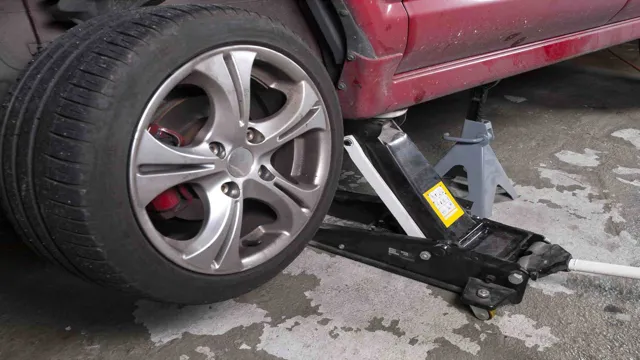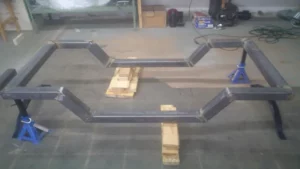When it comes to performing maintenance on your vehicle, properly lifting it up is crucial to ensure your safety and the protection of your car. Jack stands are an essential tool for lifting your car and performing repairs or maintenance underneath. However, it’s important to know how to use jack stands safely to prevent accidents and injuries.
Using jack stands is fairly simple, but it requires attention to detail and following the proper safety procedures. First, you’ll need to find a level surface to park your vehicle on and engage the emergency brake. Then, locate the recommended jacking points for your particular make and model.
These points are typically indicated in the owner’s manual. Next, position the jack stands under the jacking points on both sides of the vehicle. Slowly lower the car onto the jack stands and ensure they are securely in place.
It’s also a good idea to give the car a gentle shake to make sure it’s stable before working underneath it. Remember, never rely solely on the jack to hold up your vehicle. Always use jack stands as a safety backup.
Also, be sure to use proper lifting techniques when jacking up your car, and never exceed the weight limit of the jack stands. In conclusion, using jack stands to lift your car safely is a simple process, but it’s important to follow the proper procedures to prevent accidents or injuries. By taking your time and exercising caution, you can confidently perform maintenance on your vehicle and keep both yourself and your car protected.
Choosing the Right Equipment
When it comes to car repairs, choosing the right equipment is crucial to ensure a safe and effective outcome. If you need to jack up your car on jack stands, it’s important that you have the right tools on hand. Start by selecting a sturdy pair of jack stands that can support the weight of your vehicle.
Look for stands that are designed to hold at least 25% more weight than your car. Additionally, you’ll need a hydraulic floor jack rated for at least the weight of your car. Before you begin, make sure you’re working on a flat and solid surface, and that your car is in park or first gear with the parking brake engaged.
It’s also important to follow the manufacturer’s instructions for your specific equipment. If you’re unsure about how to jack up your car safely, consider consulting a mechanic or expert. With the right equipment and caution, you can safely lift your car onto jack stands for repairs or maintenance.
Selecting the Right Jack Stands
When it comes to working on your car, safety should always be a top priority. That’s why choosing the right jack stands is so important. You don’t want to skimp on quality when you’re supporting thousands of pounds of vehicle weight.
Make sure you choose a pair of jack stands that are rated for your vehicle’s weight, and always use them on a level surface. It’s also important to consider the height of the jack stands. You don’t want them to be too tall or too short for the job at hand.
When in doubt, always err on the side of caution and choose a taller jack stand. It’s better to have too much height than not enough. Another great tip is to choose jack stands with a wide base.
This will provide added stability and reduce the risk of wobbling or tipping over. With a little bit of research and attention to detail, you can choose the right jack stands that will keep you safe while working on your car.

Choosing the Right Jack
When it comes to choosing the right jack for your equipment, there are a few things to consider. First and foremost, you need to make sure that the weight capacity of the jack is appropriate for the equipment you will be using it on. Using a jack with a lower weight capacity than necessary can lead to dangerous accidents, so it’s important to choose one that is up to the task.
Additionally, you’ll want to consider the height of the jack, as this can affect how easy it is to use in different situations. A jack with a lower profile may be easier to maneuver in tight spaces, while a taller jack may be needed for larger equipment. Finally, consider the overall durability and reliability of the jack.
Investing in a high-quality jack may cost more upfront, but it can save you money in the long run by eliminating the need for frequent repairs or replacements. So when choosing the right jack for your equipment, prioritize weight capacity, height, and durability to ensure safe and efficient use.
Preparing Your Car for Lifting
One of the most crucial aspects of lifting your car safely is preparing your vehicle correctly before hoisting it. Before you start jacking up your car on jack stands, ensure that you’re parked on a level surface and that the handbrake is on firmly. Additionally, ensure that you block the wheels that will remain on the ground to avoid any potential accidents.
Pop the hood of your vehicle and look for the recommended lifting points for your car. Next, use a jack to lift your vehicle and place jack stands at the recommended lifting points. Carefully lower your car onto the jack stands, making sure the jack stands are placed securely before removing the jack.
Finally, shake your car gently to ensure stability and double-check that everything is secured before you start any maintenance work under your vehicle. Remember, safety comes first. So, never climb under a vehicle that isn’t properly supported or secured.
Finding the Lifting Point on Your Car
If you plan to lift or elevate your car, it’s essential to locate the lifting point to avoid damaging its structure. Before starting, perform a visual inspection of your vehicle and find the manufacturer’s recommended lifting points in your manual. Your car might have decals or painted symbols under its bonnet that indicates the correct lifting points.
Prepare your vehicle by parking in a flat and stable surface. Turn off the engine and ensure the car is in gear or engaged in parking mode for safety. Never lift your car by the bumper as it won’t support the weight and can cause severe damage.
Choose an appropriate jack that matches the weight of your car and provides enough lift height. Remember that lifting a vehicle can pose risks, so take extra precautions, such as wearing gloves and eye protection, to prevent accidents.
Placing the Jack Stands
When it comes to lifting your car, preparation is essential. Before you place the jack stands, the first thing you need to do is make sure you are on a flat surface. Then, check your car’s manual to locate the ideal jacking points for your model.
These are usually indicated by small notches or arrows on the chassis. Next, take out your jack and lift your car to a suitable height. Once it’s high enough, slide the jack stands under the jacking points on either side of the car and carefully lower the car onto them.
Make sure the stands are securely locked into place and that they are level. Use the floor jack to give the car a gentle nudge to ensure it’s stable. Remember, safety is paramount when working under a car, so be sure to double-check everything before you get started.
With these steps, you can safely and securely place your jack stands and get to work on your car.
Securing Your Car on the Jack Stands
When it comes to securing your car on jack stands, proper preparation is key. Before you even think about lifting your vehicle, it’s important to make sure your parking brake is engaged and that the car is in gear (if it’s a manual transmission) or in “park” (if it’s an automatic transmission). Once you’ve done that, grab a wheel chock or two and place them in front of and behind the tires that will remain on the ground.
This will prevent the car from rolling forward or backward as you lift it onto the jack stands. It’s also a good idea to inspect your jack stands to ensure that they’re in good condition and that they’re rated to handle the weight of your vehicle. Finally, always use your jack stands on a level surface and make sure they’re placed securely under the vehicle’s designated jacking points.
Taking these precautions will help ensure that your car stays safe and secure while it’s up on the jack stands.
Lowering Your Car Back to the Ground
If you’re looking to lower your car back down to the ground after working on it, it’s important to know how to jack it up on jack stands properly. First, find a level surface and ensure your car is in park with the emergency brake engaged. Position the jack stands under the jacking points indicated in your car’s manual.
Then use the jack to lift the car until it’s slightly higher than the height of the jack stands. Place one jack stand at a time under each jacking point and lower the car slowly onto the stands. Once the car is secure, gently shake it to ensure it’s stable before proceeding to work.
Remember to always follow the manufacturer’s guidance and never work under a vehicle that is supported by only a jack. Taking these steps will guarantee a safer and more successful job with your lowered car.
Removing the Jack Stands
Removing the jack stands from your car and lowering it back to the ground can be a bit intimidating if you’re not familiar with the process. But it’s important to do it correctly to avoid any accidents or damage to your vehicle. Before you start, double-check that all the lug nuts on your wheels are properly tightened.
Then, use a jack to lift the vehicle off the jack stands and slowly lower it back down to the ground. Make sure you’re using a level surface and that the car is stable before completely removing the jack stands. Once everything is secure, carefully remove the stands and place them back in their storage location.
It’s always better to be safe than sorry, so take your time and triple check everything before you start driving. By following these simple steps, you’ll be able to remove the jack stands from your car safely and with ease.
Lowering Your Car with the Jack
Lowering your car with the jack is an essential skill that every car owner should learn. Once you’re done fixing your car, the next step is to lower it to the ground. However, this step should be done cautiously because dropping your car too quickly can lead to damage and accidents.
To lower your car, start by loosening the jack screw before removing it carefully. You can then replace any tires that you removed and tighten the lugs using a wrench. Finally, lower the car slowly to the ground, ensuring that it is level and stable before releasing the jack completely.
By following these simple steps, you can quickly and safely get your car back on the ground, ready to hit the road. Remember, safety always comes first!
Conclusion
In conclusion, if you’re looking to jack up a car on jack stands, it can seem overwhelming at first. But fear not, with a little patience and these step-by-step instructions, you’ll be jackin’ it up with the best of them in no time. So grab your trusty jack, locate those secure points on your vehicle, and get ready to elevate your ride to new heights.
And remember, always play it safe – a little extra caution can prevent a whole lot of regret!”
FAQs
What are the safety precautions to take before jacking up a car on jack stands?
Before jacking up a car on jack stands, ensure that the car is parked on a flat and stable surface, the handbrake is engaged, and the wheels are chocked. Additionally, always use jack stands that can hold the weight of your car and position them correctly under the recommended jacking points.
Can I use a scissor jack to lift my car and then place it on jack stands?
No, it is not recommended to use a scissor jack to lift your car and then place it on jack stands. This can be dangerous as scissor jacks are not designed for extended use and may give way under the weight of your car. Always use a floor jack to lift your car and then place it on jack stands.
How do I properly position jack stands under my car?
Positioning jack stands correctly is crucial to ensure your car is safely lifted. The recommended jacking points can be found in your car owner’s manual. Once you have located them, position the jack stands on level ground and ensure they are aligned with the jacking points. Carefully raise the car with a jack and lower it onto the jack stands.
How many jack stands do I need to lift my car safely?
You will need at least two jack stands to lift your car safely. It is recommended to use four jack stands to provide maximum stability and safety. If you only have two jack stands, you can lift one end of the car at a time and support it with the stands before proceeding to the other end.
Can I move my car once it is on jack stands?
No, you should never move your car while it is resting on jack stands. Jack stands are not designed to support the weight of a moving car and this can be extremely dangerous.
Can I use bricks or cinder blocks instead of jack stands?
No, bricks or cinder blocks should never be used in place of jack stands. They are not stable enough to support the weight of a car and can easily crumble or shift, leading to a serious accident. It is always recommended to use proper jack stands that are designed for the weight of your car.
How do I remove the jack stands once I am done working on my car?
To remove the jack stands, use a floor jack to lift the car slightly and remove the stands one at a time. Lower the car slowly and double-check that all the stands have been removed before driving away.






